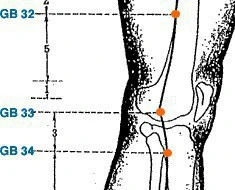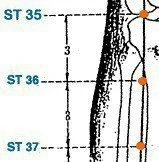Needling Multiple Acupuncture Points - Brain Activation More Than The Sum
For practitioners who are interested in the scientific analysis of "how" acupuncture works there are a number of interesting avenues to pursue. From a multitude of studies we know that acupuncture modulates areas in the brain which then over hours and days serve to initiate balancing changes in bodily functions. Some of these changes are extremely reliable - that is the same point lights up essentially the same areas of the brain and has the same internal effect(s) each time it is needled. Other points, however, may light up different areas of the brain in different individuals and initiate a more auto-regulating function - so the same point may raise blood pressure in a person with low blood pressure and lower it in someone where it is high. Essentially this means that some points appear to have an effect that is directly related to the needs of the individual (i.e. their specific health issues), while other acupuncture points appear to have distinct direct functions on nearly every patient regardless of what they have happening health wise.
Another avenue is whether acupuncture point placement or specificity contributes to stronger effects than non-specific needling. Studies in this arena are part of the exploration of sham acupuncture or needling non-acupuncture points to see if needling more precise acupuncture points is more effective (example). Most studies have shown that there is a difference in measurable changes in the body the more "correct" the acupuncture needle is placed. Although when you get into multiple acupuncture point utilization at times the results appear to be more mixed than one might expect. That is, patients may get similar results with "sham" needling as they do with the utilization of a proper protocol. This avenue still needs much exploration.
All of this leads into the study I'm primarily writing about today. While we have ample studies to at least have a strong idea of the mechanisms through which the effects of acupuncture are modulated in the body. Once you start using multiple acupuncture points these effects get very difficult to study, in large part because of how many areas of the brain may be effected by a combination of acupuncture points. For healing purposes, particularly with systemic conditions this is a great "benefit" of acupuncture. But for purposes of scientific study it is like walking into a labryinth of mirrors. Every where you look there is an effect, but every where you look there is something different or more than what you expected. For the daily clinical practice of acupuncture this is where you rely on the many generations of practitioners before you and in the broad and deep sets of theories that form the foundation of Chinese Medicine. But it doesn't hurt anyone to dig a little deeper using the tools of modern science.
This is primarily what researchers from various medical facilities in Guandong China, including Southern Medical University and the First Affiliated Hospital of Jinan University, set out to explore. In this fMRI brain study researchers explored two very commonly used and very important acupuncture points and looked at brain changes when both were needled together vs. when they were needled individually. The two points used were:
 GB 34 - found in a depression anterior and inferior to the head of the fibula.
GB 34 - found in a depression anterior and inferior to the head of the fibula.
Arguably one of the more influential points in the body for all soft tissue issues, anywhere in the body.
Also has uses for liver and gallbladder related disease - gallstones, hepatitis, jaundice, etc.
 ST 36 - found 3 cun below ST 35, one finger width lateral from the anterior border of the tibia.
ST 36 - found 3 cun below ST 35, one finger width lateral from the anterior border of the tibia.
One of the most important acupuncture points for strengthening of the blood and qi of the body - which would "translate" in western terms to the strength of the muscles, metabolic functions and immunity, among other benefits.
Also useful for a range of spleen related issues abdominal pain, bloating, GERD, etc.
Of interest is if combinations of acupuncture points create more changes than the sum of their individual effects. In other words, will there be areas of the brain that light up that wouldn't light up, or light up with the same intensity, when both points are needled that don't light up at all or with the same intensity when they are needled individually. Answers to questions like these may not change much of daily clinical practice - or they may lead to very interesting point combinations that are stronger and more effective for certain conditions than combinations arrived at from theory alone. It is nice to be open to these possibilities even if on the surface these types of studies violate many tenants of clinical practice.
The researchers in this small study recruited 4 men and 6 females who were young and in good health - median age 23. Using fMRI and ReHo (regional homogenity) indices they looked at the effects of needling the points individually and in combination and they found the following for the combination needling group:
- Compared with the ST 36 group they found higher ReHo values in the left inferior parietal lobe (language, body image, facial recognition, ...) and right frontal cortex (dopamine sensitive functions, reward systems, short-term memory, motivation, ....)
- Compared with the GB 34 group they found higher ReHo values in the posterior right cerebellum (happiness, sleep, consciousness), dorsal anterior cingulate (reward based decision making), left and right middle frontal gyrus (attention, working memory) and right inferior parietal lobe (language, body image facial recognition).
The researchers concluded that needling multiple acupncture points could "more widely activate areas of the brain" compared with indivdual acupuncture points and that these combinations could activate "new brain areas and generate new curative effects" - again over individual points.
All things considered there is nothing surprising for practitioners here. But the idea that you might only be able to effect a certain part of the brain with certain point combinations has an immense number of possible clinical possibilities. This, of course, would take many more studies to further expand these theories, but it is an interesting starting point. Perhaps this will only verify what we already know from our generations of theory - even that as an outcome would be fine - just to know more about "how" acupuncture works. My guess, however, is that looking down these corridors of effect will lead to better more consistent clinical outcomes for certain conditions if given enough attention.
tag @yinyanghouse for questions/comments